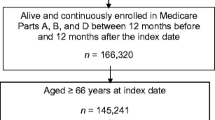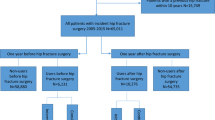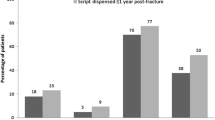Abstract
This study assessed the proportion of patients treated with anti-osteoporotic drugs during the 1-year period after hospitalization for a fracture, and the influence of a guideline in the period 1998–2000 on the likelihood of receiving treatment for osteoporosis after a fracture. Patients were assessed retrospectively for anti-osteoporotic drug use during a 1-year period following hospitalization for non-traumatic fracture. The PHARMO system, a population-based database (n=865,000) containing drug and hospitalization data of community-dwelling inhabitants of defined areas in the Netherlands, was used. The study population comprised 1654 patients age 50 years and over who were admitted to hospital for a fracture resulting from a fall during the period 1998–2000. The treatment rate of newly treated patients and the change in treatment rate throughout the period 1998–2000 were the outcome measures. The majority of these patients were women (73%), and had femur fractures (51%). In total, 247 out of 1654 patients (15%) were prescribed anti-osteoporotic drugs within 1 year after discharge from the hospital. Of these 247 patients, 86 were newly treated, mainly with bisphosphonates in the year after discharge following the fracture, yielding a new treatment rate of 5%. The likelihood of receiving treatment for osteoporosis following fracture did not change with the calendar year of fracture (OR 0.95; 95% CI: 0.68–1.30). The result of this study shows that despite the introduction of an osteoporosis treatment guideline in 1999 recommending treatment for fracture patients, most of the time, fracture patients are not being treated for osteoporosis. Thus, to a large extent, osteoporosis remains under-treated.
Similar content being viewed by others
References
Geusens P, Autier P, Boonen S, Vanhoof J, Declerck K, Raus J (2002) The relationship among history of falls, osteoporosis, and fractures in postmenopausal women. Arch Phys Med Rehabil 83:903–906
Melton LJ 3rd (2001) The prevalence of osteoporosis: gender and racial comparison. Calcif Tissue Int 69:179–181
Tenenhouse A, Joseph L, Kreiger N, Poliquin S, Murray TM, Blondeau L et al. (2000) Estimation of the prevalence of low bone density in Canadian women and men using a population-specific DXA reference standard: the Canadian Multicentre Osteoporosis Study (CaMos). Osteoporos Int 11:897–904
Doube A (1999) Managing osteoporosis in older people with fractures. BMJ 318:477–478
Johnell O, Oden A, Caulin F, Kanis JA (2001) Acute and long-term increase in fracture risk after hospitalisation for vertebral fracture. Osteoporos Int 12:207–214
Klotzbucher C, Ross P, Landman P, Abott TI, Berger M (2000) Patient with prior fractures have an increased risk of future fractures: a summary of literature and statistical synthesis. J Bone Miner Res 15:721–739
Lindsay R, Silverman SL, Cooper C, Hanley DA, Barton I, Broy SB et al. (2001) Risk of new vertabral fracture in the year following a fracture. JAMA 285:320–323
Castel H, Bonneh DY, Sherf M, Liel Y (2001) Awareness of osteoporosis and compliance with management guidelines in patients with newly diagnosed low-impact fractures. Osteoporos Int 12:559–64
McLellan AR (2003) Identification and treatment of osteoporosis in fractures. Curr Rheumatol Rep 5:57–64
Pal B (1999) Questionnaire survey of advice given to patients with fractures. BMJ 318:500–501
al-Allaf AW, Pal B, Reid N (1998) An audit of post fracture rehabilitation with special emphasis on osteoporosis assessment and treatment. Clin Exp Rheumatol 16:451–453
Kamel HK, Hussain MS, Tariq S, Perry HM, Morley JE (2000) Failure to diagnose and treat osteoporosis in elderly patients hospitalized with hip fracture. Am J Med 109:326–328
Torgerson DJ, Dolan P (1998) Prescribing by general practitioners after an osteoporotic fracture. Ann Rheum Dis 57:378–379
Cuddihy MT, Gabriel SE, Crowson CS, Melton LJ 3rd (2002) Osteoporosis intervention following distal forearm fractures. Arch Int Med 162:421–426
Freedman KB, Kaplan FS, Bilker WB, Strom BL, Lowe RA (2000) Treatment of osteoporosis: are physicians missing an opportunity? J Bone Joint Surg [Am] 82-A:1063–1070
Gezondheidsraad: Commissie Osteoporose (1998) Preventie van aan osteoporose gerelateerde fracturen. Gezondheidsraad, Rijswijk
CBO (2002) Osteoporose Tweede Herziene Richtlijn. Kwaliteitsinstituut voor de Gezondheidszorg CBO, Utrecht
Elders PJ, van Keimpema JC, Petri H, Matser A (1999) NHG-standaard Osteoporose. Huisarts Wet 42:115–128
Herings RMC (1993) PHARMO: a record linkage system for postmarketing surveillance of prescription drugs in the Netherlands. Doctorate, Utrecht University
Acknowledgement
This study was supported by Merck & Co. USA.
Author information
Authors and Affiliations
Corresponding author
Rights and permissions
About this article
Cite this article
Panneman, M.J.M., Lips, P., Sen, S.S. et al. Undertreatment with anti-osteoporotic drugs after hospitalization for fracture. Osteoporos Int 15, 120–124 (2004). https://doi.org/10.1007/s00198-003-1544-7
Received:
Accepted:
Published:
Issue Date:
DOI: https://doi.org/10.1007/s00198-003-1544-7




